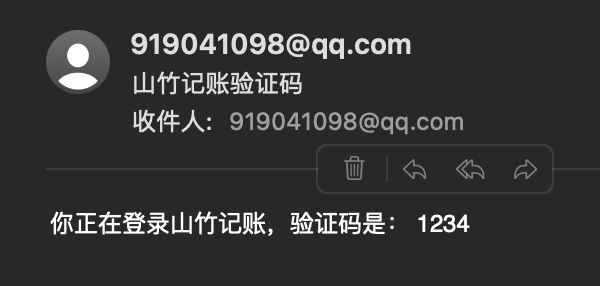mock、order、enum
测试邮件被发送成功
由于之前只测了是否发送code,并没有全链路测是否发送邮件。
修改validation_codes_controller.rb,在保存code的时候调用UserMailer.welcome_email的方法。
class Api::V1::ValidationCodesController < ApplicationController
def create
code = SecureRandom.random_number.to_s[2..7]
validation_code = ValidationCode.new email: params[:email],
kind: 'sign_in', code: code
if validation_code.save
UserMailer.welcome_email(validation_code.email)
render status: 200
else
render json: { errors: validation_code.errors }, status: 400
end
end
enduser_mailer.rb修改了welcome_email的方法。接口传递的参数email带入,并给带入到邮箱发送验证码邮件。
class UserMailer < ApplicationMailer
def welcome_email(email)
validation_code = ValidationCode.find_by_email(email)
@code = validation_code.code
mail(to: email, subject: '山竹记账验证码')
end
end接口测试方法中加上对于邮箱发送的验证。
require 'rails_helper'
require 'rspec_api_documentation/dsl'
resource "验证码" do
post "/api/v1/validation_codes" do
parameter :email, type: :string
# 接受一个参数email 类型为 string
let(:email) { '1@qq.com' }
# 请求时带上测试用例
example "请求发送验证码" do
expect(UserMailer).to receive(:welcome_email).with(email)
do_request
expect(status).to eq 200
expect(response_body).to eq ' '
end
end
end使用rails console 手动测试email,执行bin/rails c,进入控制台的rail环境。创建一个validaton_code,validation_code = ValidationCode.new email:'919041098@qq.com', kind: 'sign_in',code: '1234',然后在数据库保存validation_code.save,然后在执行测试API的方法UserMailer.welcome_email('919041098@qq.com').deliver。之后可以在邮箱中看到发送的邮件。

重构create_validation_code
rails优化的一个特点是将controller层写的短一点,如果有数据相关的操作尽量写在model层。
class Api::V1::ValidationCodesController < ApplicationController
def create
validation_code = ValidationCode.new email: params[:email], kind: 'sign_in'
if validation_code.save
render status: 200
else
render json: { errors: validation_code.errors }, status: 400
end
end
endclass ValidationCode < ApplicationRecord
validates :email, presence: true
# 在创建之前执行 generate_code 方法
before_create :generate_code
# 创建之后执行 send_email 方法
after_create :send_email
def generate_code
self.code = SecureRandom.random_number.to_s[2..7]
end
def send_email
UserMailer.welcome_email(self.email)
end
end由于用户可能会发送多次请求,我们发送的时候需要找到最新发送的一条进行邮箱发送。
class UserMailer < ApplicationMailer
def welcome_email(email)
validation_code = ValidationCode.order(created_at: :desc).find_by_email(email)
@code = validation_code.code
mail(to: email, subject: '山竹记账验证码')
end
endrails中使用enum
解决kind的显示问题
class ValidationCode < ApplicationRecord
validates :email, presence: true
before_create :generate_code
after_create :send_email
enum kind: { sign_in: 0, reset_password: 1 }
def generate_code
self.code = SecureRandom.random_number.to_s[2..7]
end
def send_email
UserMailer.welcome_email(self.email)
end
end之后可以在ruby环境下的终端重启一下刚写的代码reload!。然后在进行验证v1 = ValidationCode.new email:'919041098@qq.com', kind: 'sign_in',code: '1234',然后答应v1,就可以看到创建的内容,或是通过插件查看整个表,如下所示。若是要清空数据库可以执行ValdiationCode.destory_all。

防止重复发送验证码
防止发送验证码太频繁,然后返回429。
class Api::V1::ValidationCodesController < ApplicationController
def create
# 写法一
if ValidationCode.exists?(email: params[:email], kind:'sign_in',created_at: 1.minute.ago..Time.now)
render status: :too_many_requests
return
end
# 写法二
# return render status: :too_many_requests if ValidationCode.exists?(email: params[:email], kind:'sign_in',created_at: 1.minute.ago..Time.now)
validation_code = ValidationCode.new email: params[:email], kind: 'sign_in'
if validation_code.save
render status: 200
else
render json: { errors: validation_code.errors }, status: 400
end
end
end接口测试中就直接在后面在做一次请求,期待返回的status为429。
require 'rails_helper'
require 'rspec_api_documentation/dsl'
resource "验证码" do
post "/api/v1/validation_codes" do
parameter :email, type: :string
# 接受一个参数email 类型为 string
let(:email) { '1@qq.com' }
# 请求时带上测试用例
example "请求发送验证码" do
expect(UserMailer).to receive(:welcome_email).with(email)
do_request
expect(status).to eq 200
expect(response_body).to eq ' '
do_request
expect(status).to eq 429
end
end
end由于需要区分两种测试,分别是requests和acceptance目录下的测试。需要删除掉无用的测试用例代码,然后终端执行rspec,没有报错则为成功。详细代码内容可见链接。